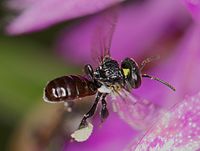
Photo from wikipedia
Polysaccharides are biobased polymers obtained from renewable sources. They exhibit various interesting features including biocompatibility, biodegradability, and nontoxicity. Microbial polysaccharides are produced by several microorganisms including yeast, fungi, algae, and… Click to show full abstract
Polysaccharides are biobased polymers obtained from renewable sources. They exhibit various interesting features including biocompatibility, biodegradability, and nontoxicity. Microbial polysaccharides are produced by several microorganisms including yeast, fungi, algae, and bacteria. Microbial polysaccharides have gained high importance in biotechnology due to their novel physiochemical characteristics and composition. Among microbial polysaccharides, xanthan, alginate, gellan, and dextran are the most commonly reported polysaccharides for the development of biomimetic materials for biomedical applications including targeted drug delivery, wound healing, and tissue engineering. Several chemical and physical cross‐linking reactions are performed to increase their technological and functional properties. Owning to the broad‐scale applications of microbial polysaccharides, this review aims to summarize the characteristics with different ways of physical/chemical crosslinking for polysaccharide regulation. Recently, several biopolymers have gained high importance due to their biologically active properties. This will help in the formation of bioactive nutraceuticals and functional foods. This review provides a perspective on microbial polysaccharides, with special emphasis given to applications in promising biosectors and the subsequent advancement on the discovery and development of new polysaccharides for adding new products.
Journal Title: Journal of Basic Microbiology
Year Published: 2022
Link to full text (if available)
Share on Social Media: Sign Up to like & get
recommendations!